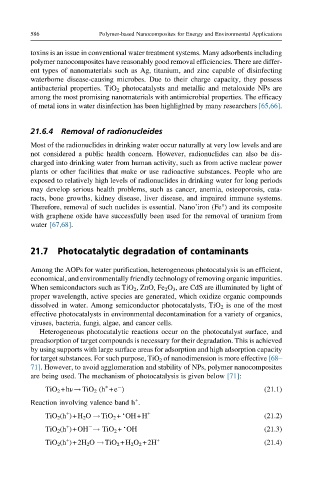Page 635 - Polymer-based Nanocomposites for Energy and Environmental Applications
P. 635
586 Polymer-based Nanocomposites for Energy and Environmental Applications
toxins is an issue in conventional water treatment systems. Many adsorbents including
polymer nanocomposites have reasonably good removal efficiencies. There are differ-
ent types of nanomaterials such as Ag, titanium, and zinc capable of disinfecting
waterborne disease-causing microbes. Due to their charge capacity, they possess
antibacterial properties. TiO 2 photocatalysts and metallic and metaloxide NPs are
among the most promising nanomaterials with antimicrobial properties. The efficacy
of metal ions in water disinfection has been highlighted by many researchers [65,66].
21.6.4 Removal of radionucleides
Most of the radionuclides in drinking water occur naturally at very low levels and are
not considered a public health concern. However, radionuclides can also be dis-
charged into drinking water from human activity, such as from active nuclear power
plants or other facilities that make or use radioactive substances. People who are
exposed to relatively high levels of radionuclides in drinking water for long periods
may develop serious health problems, such as cancer, anemia, osteoporosis, cata-
racts, bone growths, kidney disease, liver disease, and impaired immune systems.
Therefore, removal of such nuclides is essential. Nano’iron (Fe°) and its composite
with graphene oxide have successfully been used for the removal of uranium from
water [67,68].
21.7 Photocatalytic degradation of contaminants
Among the AOPs for water purification, heterogeneous photocatalysis is an efficient,
economical, and environmentally friendly technology of removing organic impurities.
When semiconductors such as TiO 2 , ZnO, Fe 2 O 3 , are CdS are illuminated by light of
proper wavelength, active species are generated, which oxidize organic compounds
dissolved in water. Among semiconductor photocatalysts, TiO 2 is one of the most
effective photocatalysts in environmental decontamination for a variety of organics,
viruses, bacteria, fungi, algae, and cancer cells.
Heterogeneous photocatalytic reactions occur on the photocatalyst surface, and
preadsorption of target compounds is necessary for their degradation. This is achieved
by using supports with large surface areas for adsorption and high adsorption capacity
for target substances. For such purpose, TiO 2 of nanodimension is more effective [68–
71]. However, to avoid agglomeration and stability of NPs, polymer nanocomposites
are being used. The mechanism of photocatalysis is given below [71]:
+
TiO 2 +hν!TiO 2 (h +e ) (21.1)
+
Reaction involving valence band h .
+
TiO 2 (h )+H 2 O !TiO 2 + OH+H + (21.2)
%
+
TiO 2 (h )+OH ! TiO 2 + OH (21.3)
%
+
TiO 2 (h )+2H 2 O !TiO 2 +H 2 O 2 +2H + (21.4)

